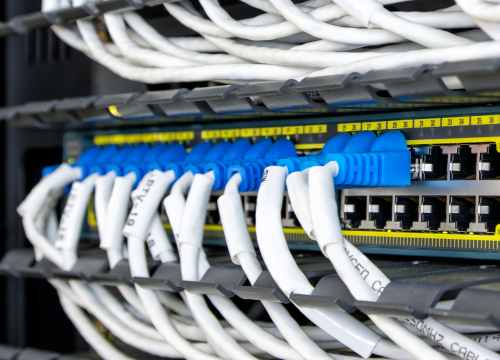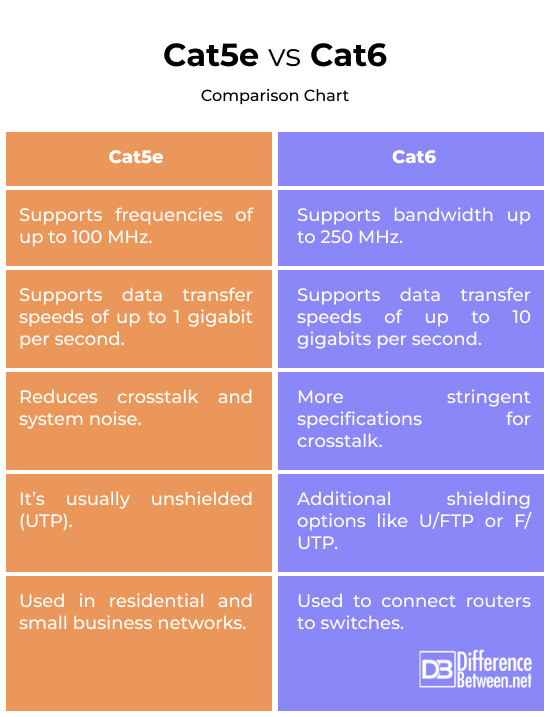Difference Between Cat5e and Cat6
Do you know what Ethernet cables are and where they are used? They’re a type of twisted-pair cable used to connect devices in a wired network. Cat5e and Cat6 are specific types of twisted-pair Ethernet cables that transmit data over copper wires.
But knowing which one to pick can be a little tricky. We’ll simplify it for you by breaking down the differences between Cat5e and Cat6 cables. Let’s get started then.

Cat5e
Cat5e, which is also written as Category 5e or Category 5 Enhanced, is a type of twisted-pair Ethernet wire used for fast networking. It’s an improved version of the original Cat5 cable that was made by TIA/EIA to cut down on crosstalk and boost speed.
The EIA/TIA-586 standard talks about five different types of UTP cables. Cat5 is one of them.
Cat5e lines can send data at speeds of up to 1,000 Mbps per second. They can handle bands up to 100 MHz and are used in home and small business networks. When it comes to 1000BASE-T, Cat5e is a great pick.

Cat6
The sixth version of twisted-pair Ethernet cables are called Cat6. They are used to connect computers to each other. It’s a better version of Cat5e and works with Gigabit Ethernet, which lets computers talk more than twice as fast as Cat5e lines.
Category 6 cables can handle up to 10 gigabits per second of data and work with Cat5 and Cat5e connections that were made earlier.
There are two main types: solid and floating. Strong ones are best for longer runs and work best in places where the wiring is set, like office buildings. Stranded wires, like patch cables, work better for short-distance wiring.
Difference between Cat5e and Cat6
Wi-Fi speed
How wide the band is the main difference. Cat5e is the most common standard for Ethernet cables, and it can handle speeds of up to 100 MHz. Cat6 is a more advanced form of Cat5 cable that can handle up to 250 MHz of bandwidth. In other words, the second one can handle more info at once.
How fast
With a top frequency of 100 MHz, Cat5e cables can send data at up to 1 gigabit per second. Cat6 cables, on the other hand, can send data at up to 10 gigabits per second. This means that Cat6 cables can talk to each other more than twice as fast as Cat5e wires. Cat6 connections, on the other hand, use all four pairs of copper wires.
Crosstalk
The copper lines in both are twisted pairs, and there are four of them. Cat6 cables, on the other hand, are the best of all four types. Their crosstalk requirements are stricter, which makes them work better in high-speed settings.
Cat5e cables also add specs for system noise and crosstalk at the far end, but not as well as Cat6.
Features and traits
Some people say that Cat5e isn’t the best cable standard, but it is definitely more flexible. It’s easier to get into tight spaces than a Cat6 wire. Cat5e is a great choice for connections with 1000BASE-T, and home and small business networks often use it.
Cat6, on the other hand, can connect 10BASE-T/100BASE-TX and 1000BASE-T devices. For better protection against outside interference, they often come with extra shielding choices like U/FTP (twisted pair that isn’t shielded but has an overall foil shield) or F/UTP (foiled twisted pair).
Cat5e vs. Cat6: Comparison Chart

Summary
Cat5e has better performance and resistance and suffers less attenuation than original Cat5 cables. It supports additional bandwidth. Cat6, on the other hand, has a better performance rating than Cat5e and suffers less from crosstalk and system noise. They’re more expensive to install than Cat5e. Cat6 is more suitable for high-performance networking environments with higher data transfer requirements.
FAQs
Are Cat5e and Cat6 connectors the same?
Yes, Cat5e and Cat6 use the same RJ45 connectors.
Can I replace Cat5e with Cat6?
Cat6 cables have thicker copper conductors for better heat dissipation, which makes them an excellent choice for Power over Ethernet (PoE). So, you can replace Cat5e with Cat6 for improved performance.
Can I plug a Cat6 cable into a CAT5 jack?
Yes, you can plug a Cat6 cable into a Cat5 jack because Cat6 cables are backward compatible with Category 5 cables.
Is Cat6A better than Cat5e?
Cat6A supports higher bandwidth and data transfer speeds than Cat5e. Cat6A is best for more demanding applications and future-proofing your network for potential upgrades.
Is Cat7 better than Cat6a?
Cat7 offers even higher bandwidth and better shielding, which helps it achieve better performance against crosstalk than Cat6A. Also, Cat7 is backward compatible with Cat6A.
Should I run Cat6 or Cat6a?
If you require higher performance, Cat6A might be a better option. However, if cost is a significant factor and your current requirements can be met with Cat6, it could be a suitable option as well.
- Difference Between Caucus and Primary - June 18, 2024
- Difference Between PPO and POS - May 30, 2024
- Difference Between RFID and NFC - May 28, 2024
Search DifferenceBetween.net :
1 Comment
Leave a Response
References :
[0]Angelescu, Silviu. CCNA Certification All-in-One For Dummies. John Wiley & Sons, 2010.
[1]Szigeti, Tim, et al. Cisco Digital Network Architecture: Intent-based Networking for the Enterprise. Cisco Press, 2018.
[2]Crayton, Christopher A. and Joel Z.R. The A+ Certification and PC Repair Handbook. Firewall Media, 2010.
[3]Rutenbeck, Jeffrey. Tech Terms: What Every Telecommunications and Digital Media Person Should Know. Taylor & Francis, 2006.
[4]Image credit: https://www.canva.com/photos/MADALeOGb50-utp-cat5e-cable-with-patch-panel/
[5]Image credit: https://www.canva.com/photos/MADFCSvks8w-server-rack-with-ethernet-network-cabling-close-up/

I like your analogy to cat6 cable and lanes on the road. I’ll have to use that when explaining cat5e vs cat6 to customers.
Check out this cool video showing how Cat5e and Cat6 cable is made:
How Low Voltage Cable is Made